Alberta locals have long-known that for some of the best hikes in the Rocky Mountains, historically without the crowds that flock to Banff, Kananaskis Country is the place to be. These days the secret is out, and Kananaskis Country now draws those same crowds. A combination of provincial budget cuts and mismanagement as well as poorly behaved hikers visiting the area means that Kananaskis Country has never been as chaotic. So should you still visit Kananaskis Country? Absolutely. It’s home to some of Alberta’s most breathtaking mountain vistas and stunning waterfalls, the latter of which I’ll focus on highlighting here. Hiking to see waterfalls in Kananaskis Country is one of my favourite things to do. Typically the hikes are shorter and well-suited for beginners or anyone who doesn’t want to spend all day hiking, plus the refreshing reward at the end makes it well worth it.
Continue reading this blog post for everything you need to know to experience these 11 awesome waterfalls in Kananaskis Country for yourself, including distance, elevation gain, how to get there, the best time to visit, and lots of photos of my experience.
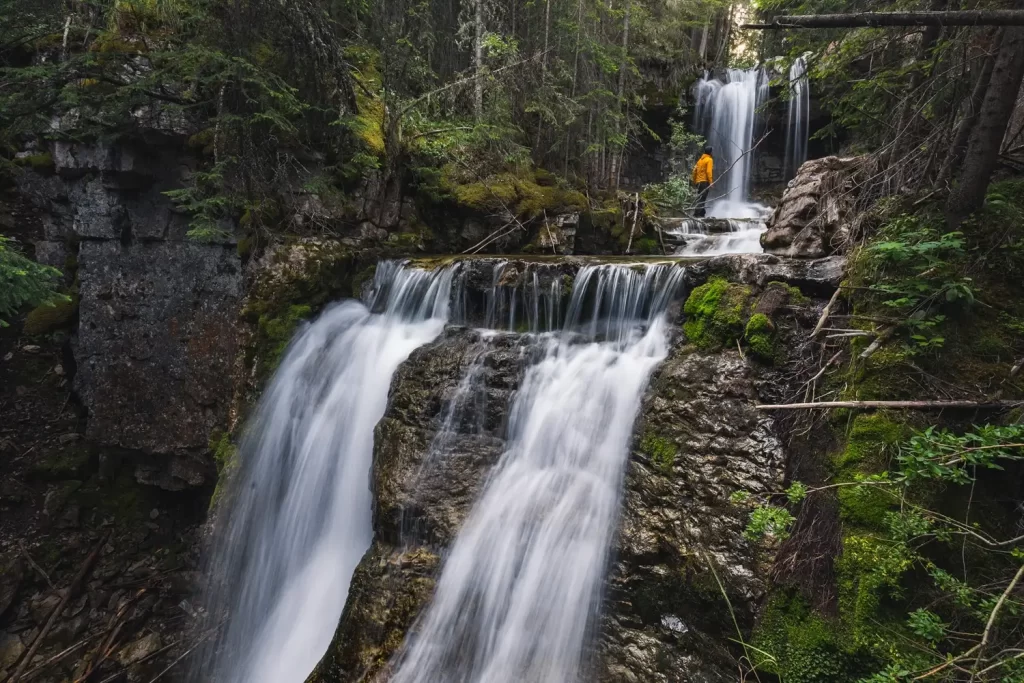
When in the outdoors it’s important to avoid harmful practices such as disturbing plants or rock-stacking, or removing any natural object from flowers to rocks, as it’s important to leave the environment as natural as possible for the animals and for fellow hikers to enjoy in perpetuity. As many flowers as there are, there are few enough that if we all took one, then there wouldn’t be any left. Take only photos, leave only footprints.
I also highly recommend reading up on Leave No Trace principles before heading anywhere into the outdoors in general. Following these important principles basically means doing your best to leave beautiful places like these Kananaskis Country waterfalls as good (if not better) than you found them, both for their preservation and for the enjoyment of other visitors.
When to Visit Waterfalls in Kananaskis Country
Like anywhere else in the Rockies where streams and rivers are fed by melting snow in the spring, any Kananaskis Country waterfall will likely be its most powerful and impressive during these months, typically becoming less and less dramatic as the summer goes on. None of the waterfalls listed here really dry up at all, so if an impressive-looking waterfall is your priority, the season doesn’t really matter. What is worth considering though, is how busy the trails are. Many of these waterfalls, being fairly accessible, see their trails get pretty busy during the day on summer weekends. If you’re looking to beat the crowds I highly advise hiking the shoulder seasons of spring and autumn, or in the mornings or evenings.
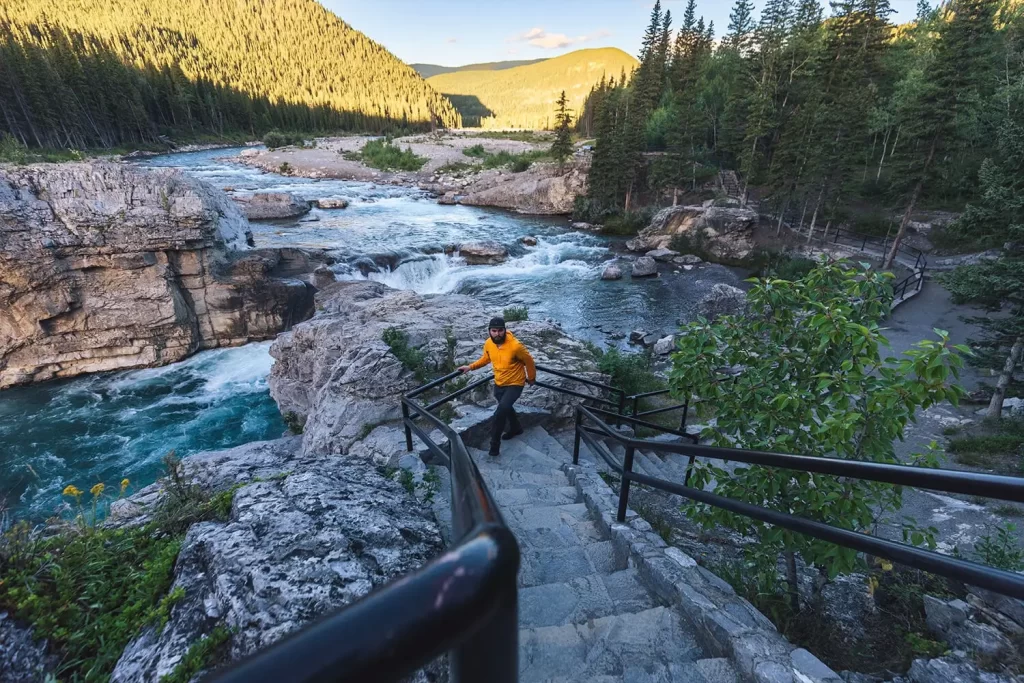
Best Kananaskis Country Waterfalls
Sarrail Falls
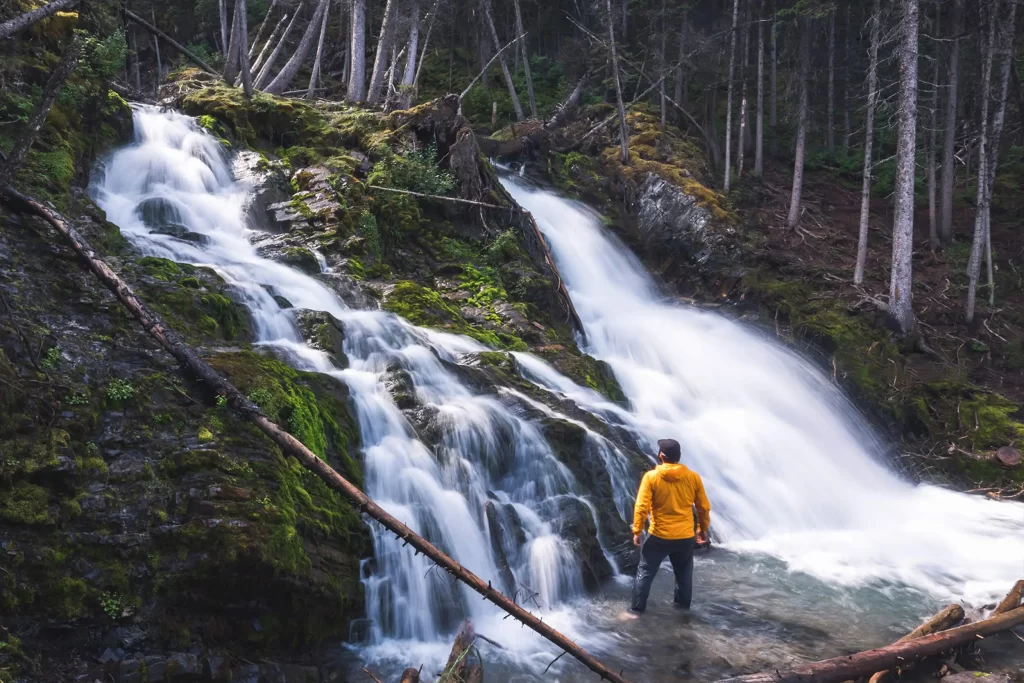
The walk to Sarrail Falls along the edge of Upper Kananaskis Lake starts off scenic, and remains so for the entirety of the hike. The views to the left stretching out over the lake with intimidating mountains in the distance would be worth it all on their own, and the incredible forest setting to the right is also a delight. This is one of the wetted and lushest hikes I’ve ever done in Alberta, and the dripping green moss reminds me more of coastal Vancouver Island than the land-locked Alberta Rockies.
As the trail only navigates around the edge of the lake, elevation gains and loss is minimal, making this a great trail for hikers looking for something unchallenging. The trail does get a little rooty and potentially muddy, though never terribly so.
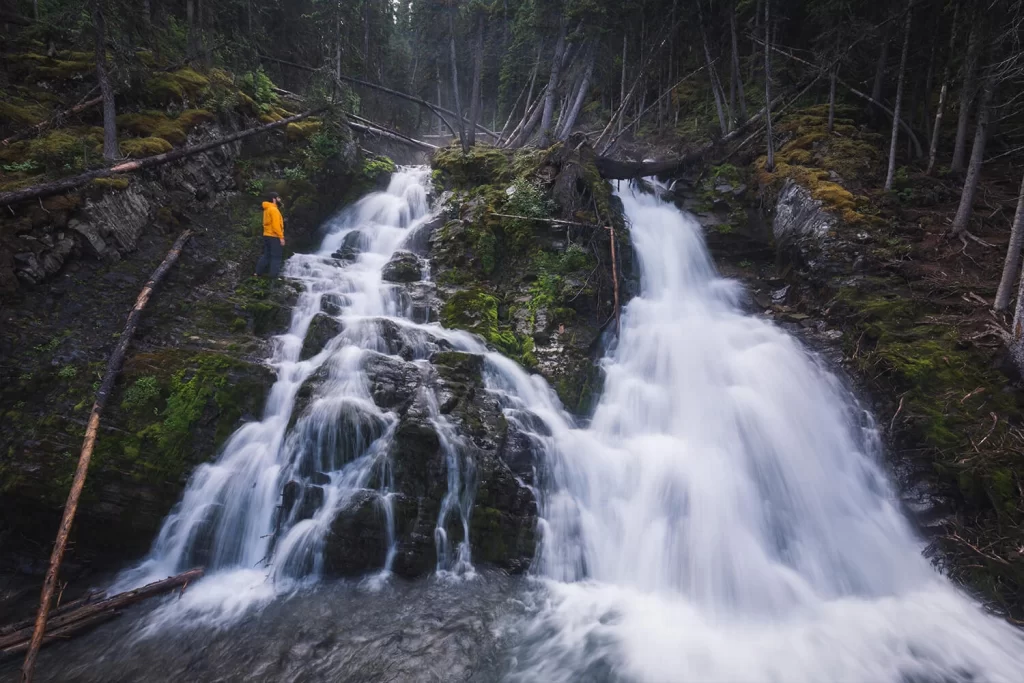
Elbow Falls
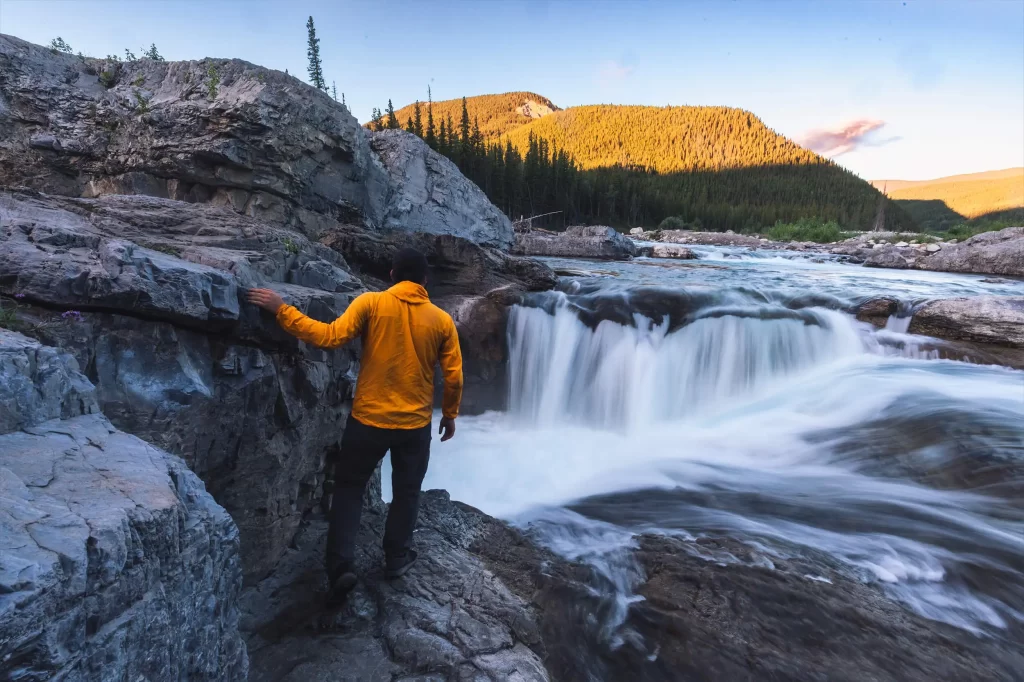
If you’ve watched The Bourne Legacy or the third Jumanji, then you’ve already seen Elbow Falls on the big screen. It’s not hard to imagine why this particular waterfall has been singled out for being featured in a few different films. Not only is it incredibly beautiful; it’s also super accessible. Located in the Bragg Creek area, one of Calgary’s favourite close hiking destinations, the Elbow River surges over a rocky ledge, surrounded by mountain peaks. (Many of which are popular hikes.) Elbow Falls is popular among families most interested by the incredibly short walk from the parking lot and among hikers who have just come back from or are about to head up some of the nearby peaks. There are a lot of reasons to visit the Bragg Creek area, but whatever you’re there for, the short detour to Elbow Falls is absolutely worth adding onto your trip.

Rainy Creek Falls
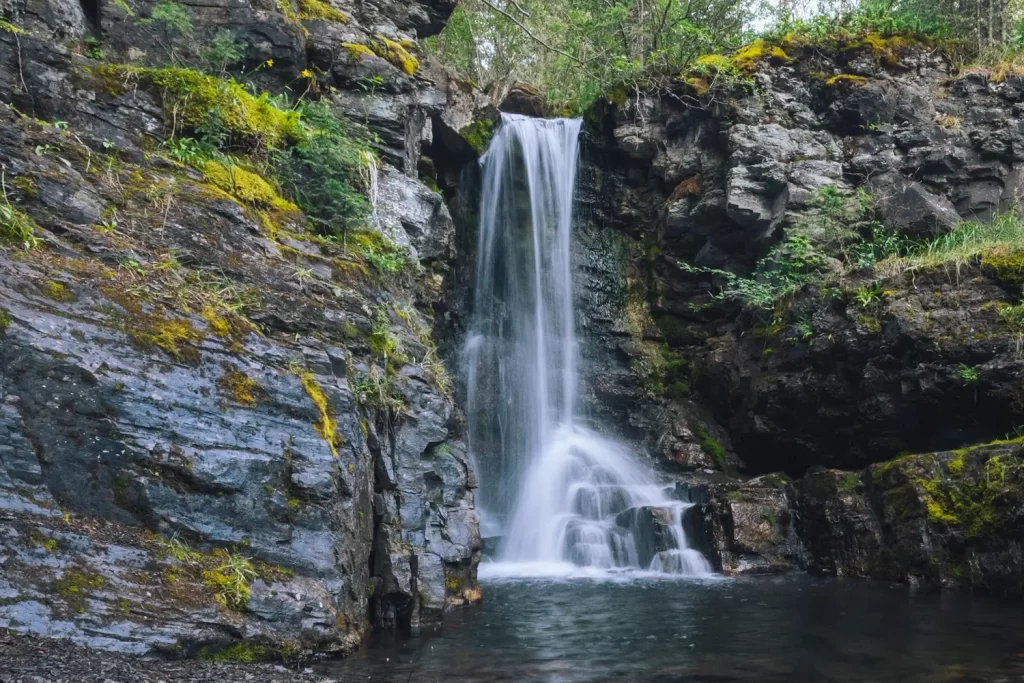
This small waterfall on Rainy Creek makes for a charming little stroll only a couple of minutes from Highway 66 near Bragg Creek, and is a quiet little spot that you’re unlikely to have to share with others. While Rainy Creek Falls by itself is far from the most exciting feature of the area, it’s a great add-on to a visit to nearby Elbow Falls or one of the lengthier hikes up the nearby peaks.
Troll Falls
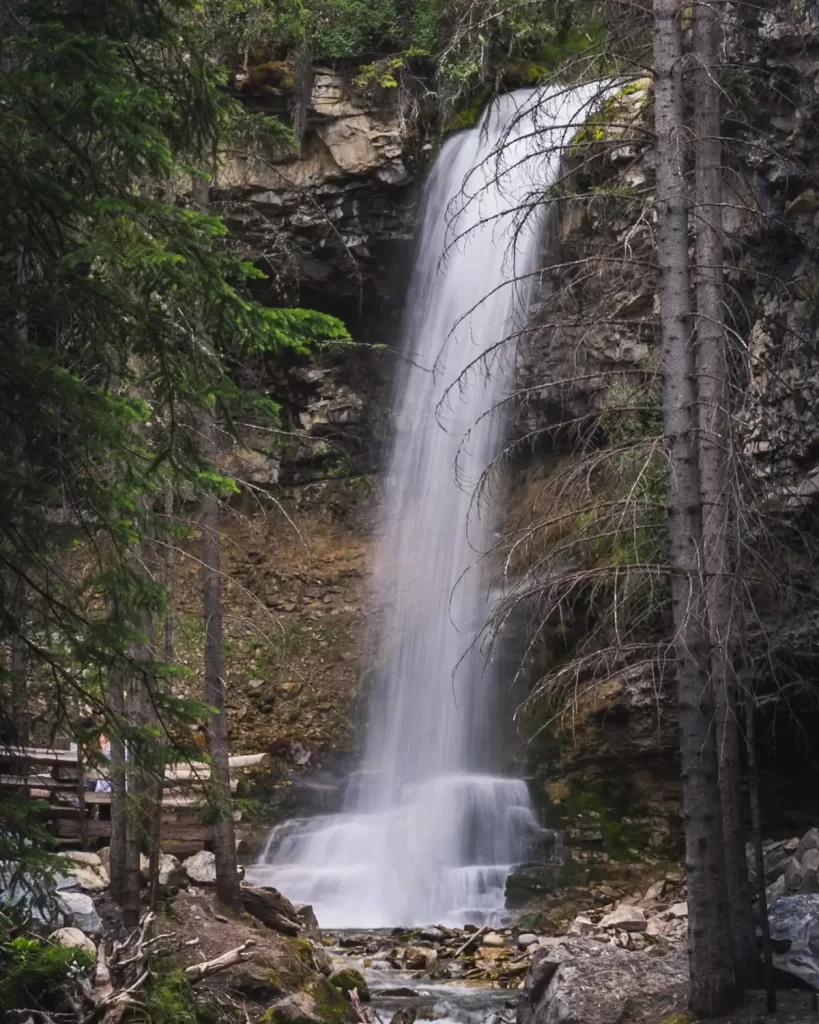
Troll falls is a classic Kananaskis Country hike, and one of the most popular hikes year-round for Calgarians seeking a day trip away from the city. The wide gentle trail features very little incline and is perfect for families or inexperienced hikers, and offers the option of extending the hike to see even more waterfalls further upstream. After only a couple kilometres of hiking through beautiful aspen forest hikers are greeted by stunning Troll Falls as it gently cascades down from a ledge up above. While plenty of people are happy to turn back here, it is also possible to follow the trail further upstream. Though the incline does become more challenging, it’s not a lot of distance upstream to Marmot Falls (sometimes known as Upper Troll Falls).
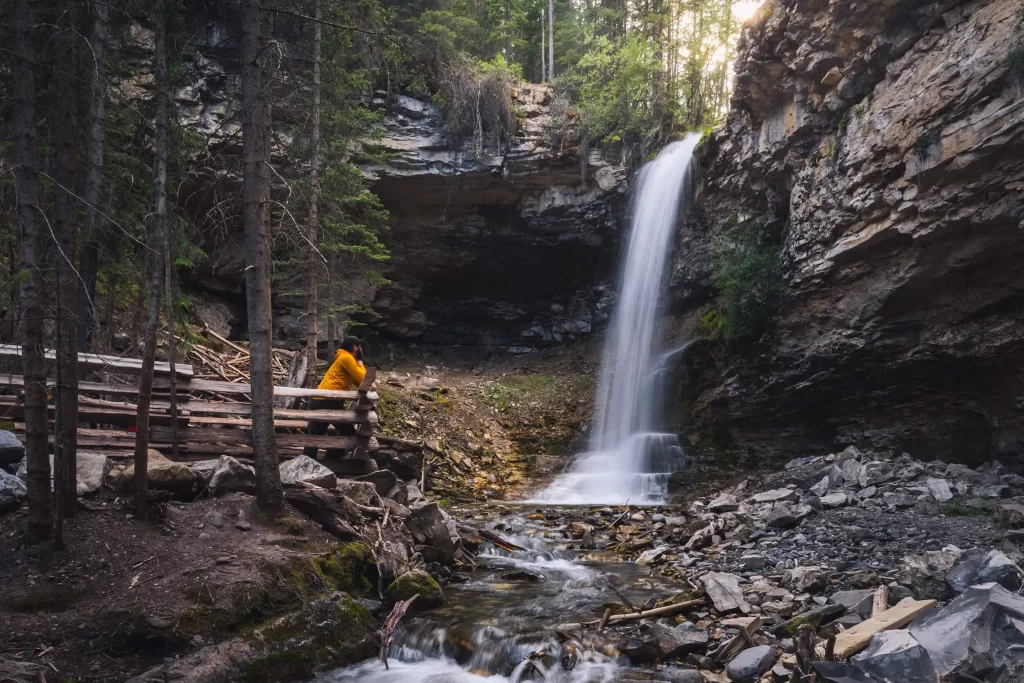
Marmot Falls
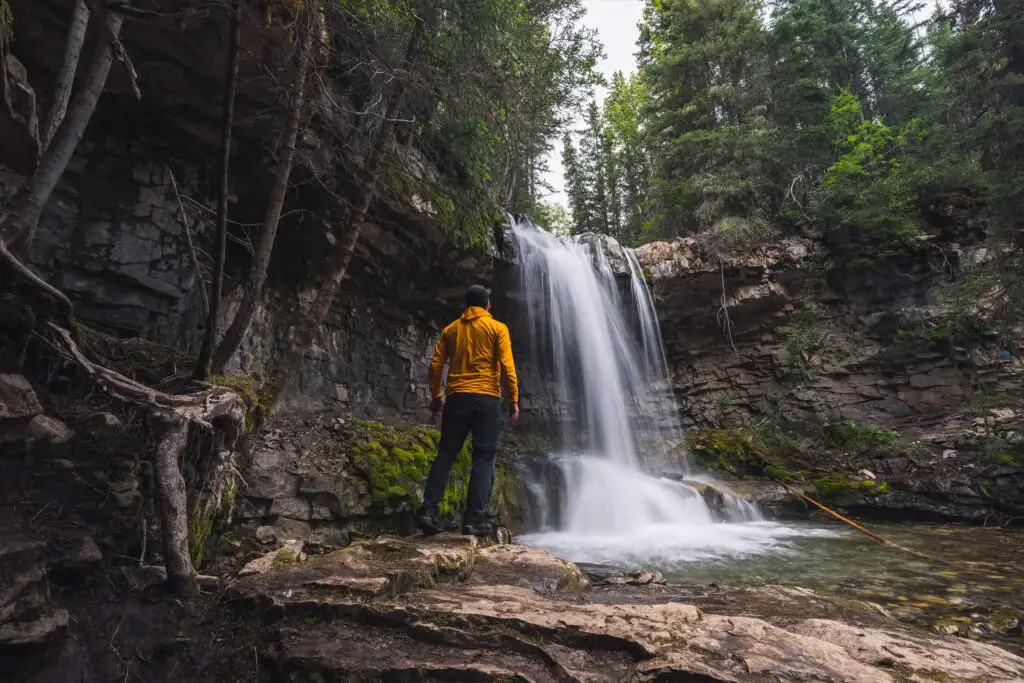
Marmot Falls is only a short distance upstream from Troll Falls, and I highly recommend visiting both. The trail up to Marmot Falls is steeper than the gentle incline to Troll Falls, so it’s technically a little more difficult to reach, but not super challenging. Plus, what really sets Marmot Falls apart is that it’s easily possible to walk behind the waterfall. Just watch your step – it gets slippery.

Edworthy Falls

Just like any of the best Kananaskis Country waterfalls, Edworthy Falls requires a bit of hiking to get to. Fortunately it’s a straightforward and incredibly scenic trail. The Edworthy Falls hike initially gains elevation as it climbs up to spectacular but busy Elbow Lake before following the Elbow River downstream for the rest of the way to the waterfall. (Yes, the same Elbow River that Elbow Falls can be found on.) The hike alongside the river along the valley bottom is at times incredibly scenic and offers spectacular views of the surrounding mountains all without working too hard, making this one of the best Kananaskis Country hikes for families.
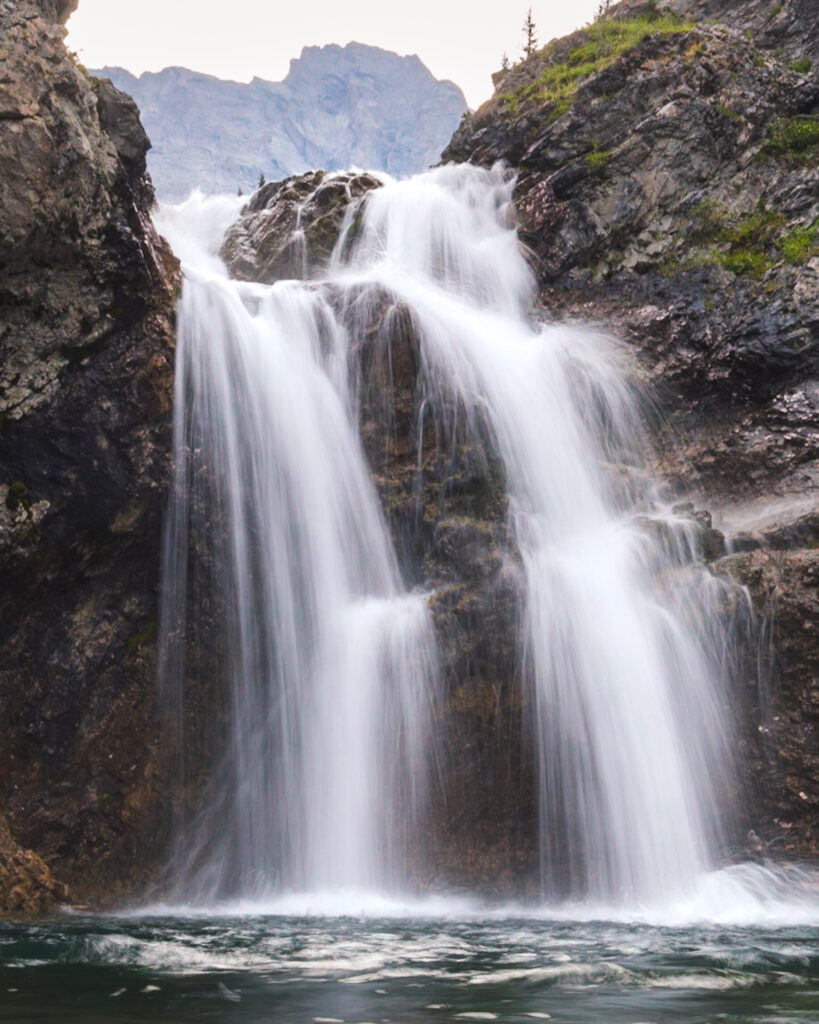
Cat Creek Falls

Cat Creek Falls is not the biggest or most impressive waterfall in Kananaskis Country, but it is nonetheless a beautiful Kananaskis waterfall located at the end of a short family-friendly hike definitely worth doing. There are plenty of shady spots to sit in the small canyon where the small waterfall splashes down, and its pool of vibrant green water is a popular place for a dip on warm summer days. The trail to Cat Creek Falls takes only about half an hour each way, and there a bunch of interpretive signs describing the forest and local geography.
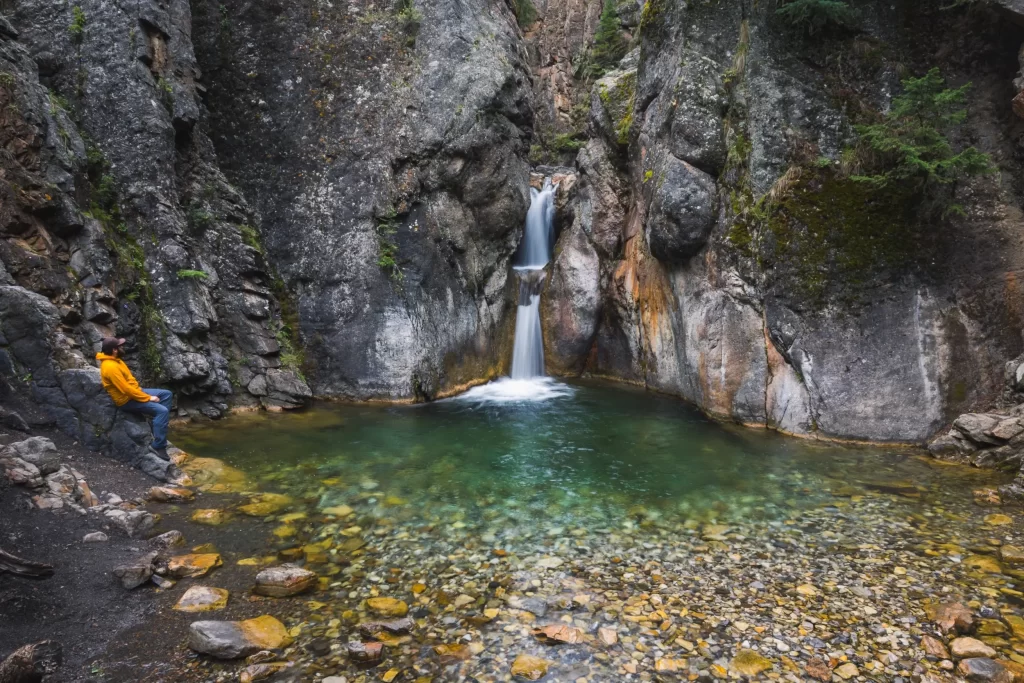
Grassi Falls
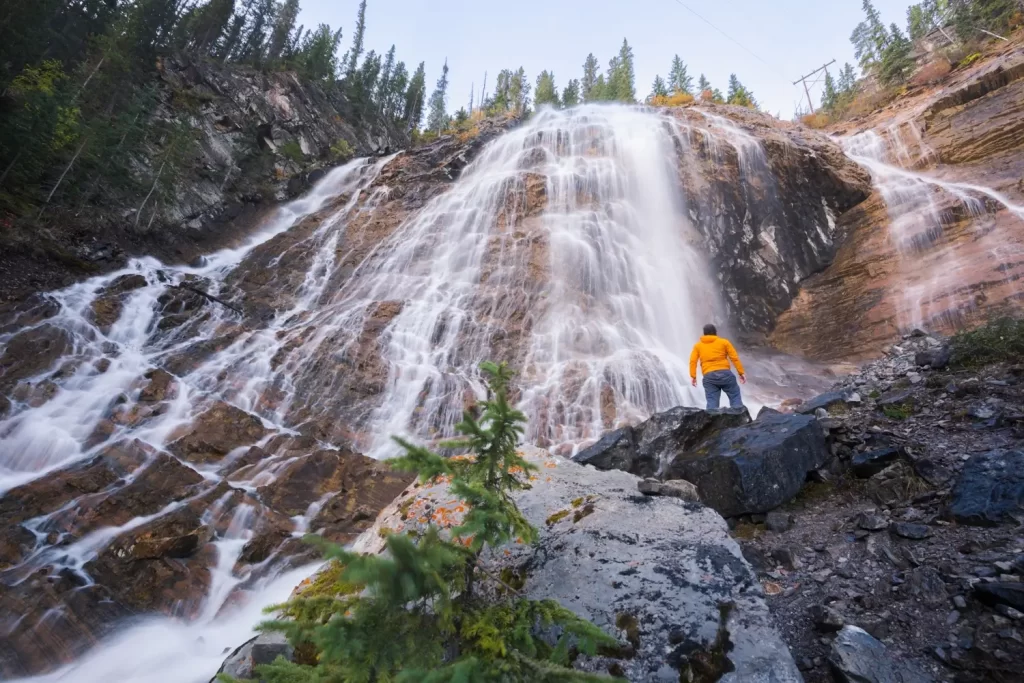
Grassi Falls is one of the most overlooked waterfalls near Canmore, despite being easily visible from many places in town. This fantastic waterfall rushes down the mountainside from Grassi Lakes (a classic local hike for beginners) towards the power station below. The only way to see the entirety of the waterfall is from a distance, with pretty decent views being obtainable just from the Grassi Lakes parking lot. There are also fantastic views of the waterfall from the Grassi Lakes hike itself, as well as short (but wet and slippery) detour to approach for yourself.
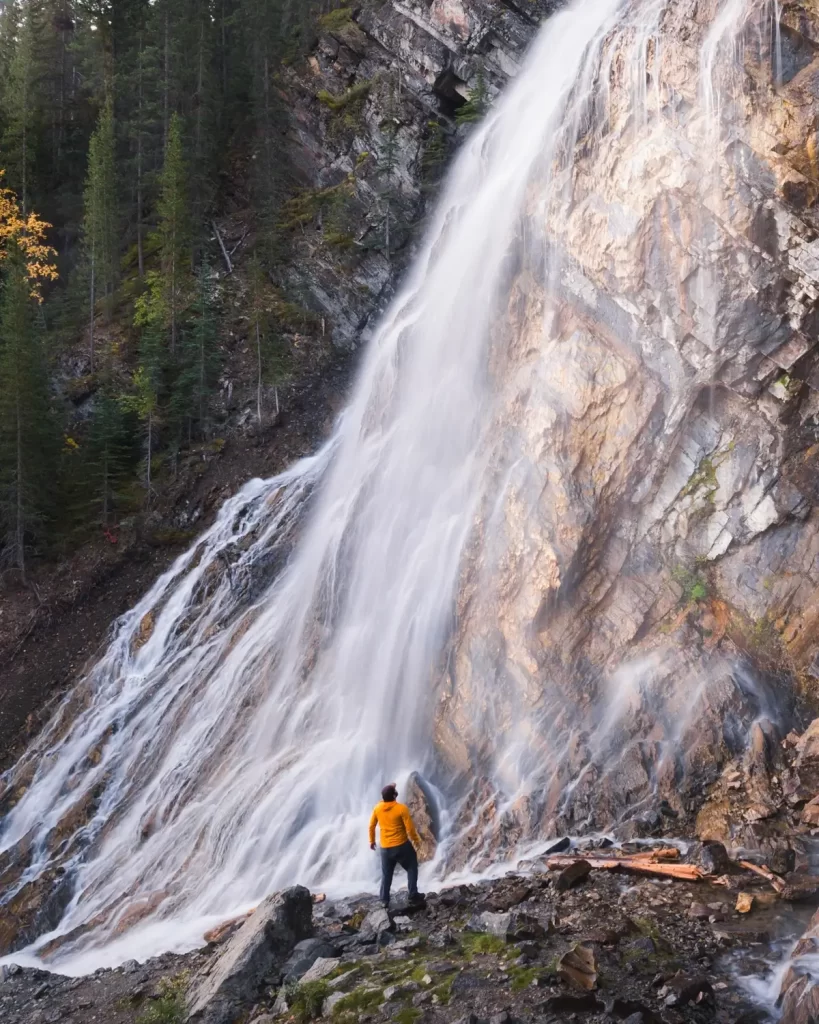
Recommended Hiking Gear



Water is a must whenever I’m hiking, especially if the sun is going to be out. My favourite water filter I’ve used is the Katadyn BeFree 0.6L, which unlike other water filters I’ve used packs up really small and lightweight. For hikes where I know there won’t be any readily available water sources along the way, I make sure to bring my own. The Hydrapak Stow 1L bottle is my go-to, for the same reason that it’s made of a soft plastic that folds up and doesn’t take up any more extra space than necessary in my pack. Finally, Aquatabs are another great option for purifying water, with one tablet being suitable for one litre of water. I previously used the Grayl water filter while travelling internationally, and though I found its hard body more convenient for day to day use and easier to drink from, it has a little too much bulk for my fast-and-light style of hiking.



The secret to all my photos of gorgeous sunset and sunrise mountaintop views? A lot of hiking in the dark. And let me speak from personal experience when I say that the last thing that you want to happen when hiking is to be caught in the dark without a headlamp. I used the Black Diamond Spot 400 for years and it worked great – until I lost it on top of a mountain somewhere. The only downside to it was having to worry about the batteries dying, though there’s also a slightly more expensive version that has a rechargeable battery. Nowadays I’m using the Petzl Actik Core, which is a bit pricier than the more budget-friendly Black Diamond, but is also brighter, more comfortable (in my opinion), and has a hybrid power system that is rechargeable but can also take AAA batteries if needed.
You won’t see me using trekking poles on shorter hikes often – but on long hikes and backpacking trips, as well as certain scrambles, they are an absolute lifesaver. I’ve invested in a high quality ultra-lightweight pair of MSR DynaLock Ascent carbon poles which, while pricey, I don’t regret one bit. If you’re not entirely sure how much use you’re going to get out of a pair of trekking poles, the best budget-friendly option would be the Trekology Trek Z 2.0. Amazon does sell a lot of cheaper Made in China-style trekking poles for cheaper, but these usually are much much heavier and not worth buying.
All the best and most long-lasting cables and power banks I’ve ever owned have been Anker. I once had a phone cable from them that lasted me over three years of daily use! That’s why I keep an Anker PowerCore Essential 20K power bank on me. Like many people I use my phone for a lot of stuff when hiking (checking in with family, using online maps, taking photos, flying my drone) so I like to be prepared for that low battery warning by having a backup power source on me just in case.



The only socks I ever buy for myself are from Darn Tough, and I almost always make sure to wear them when hiking. After years of having no problems only wearing these comfortable and rugged socks for hikes, I accidentally wore a pair of no-name socks on a hike last year and ended up with blisters on both feet. Safe to say I’m back to sticking with the Darn Tough. And the best part? They have a lifetime guarantee, meaning that if they ever wear out you can send them back for a brand new pair. For hiking footwear I go between a pair of lightweight approach shoes for quick and dirty mountain ascents or anything involving scrambling and more heavy-duty boots for longer treks. I’ve worn a couple different versions of the lightweight but super durable Arc’teryx Konseal FL 2 approach shoes for a few years now and am very impressed with the durability. I also really like the thick toecap that keeps me protected every time I stumble into a root or large rock. For longer, tougher, or muddier treks I rely on my LOWA Camino EVO GTX, which I find insanely comfortable and made of very high quality.



I wear my Ar’teryx Gamma Lightweight Pants on every single hike I go on, and on many days when I’m not hiking. After several years of abuse they are still holding together extraordinarily well, with only a few small holes from where I’ve fallen down and some slight stains from being repeatedly coated with mud. They’re lightweight, breathable, and super comfortable. For lightweight and breathable hiking tops I’m a big fan of both the Patagonia Capilene Shirt and the MEC Core Shirt. My Arc’teryx Squamish Hoody shows up in a lot of my photos. It’s super lightweight and packable, and does a great job of cutting the wind while also being pretty breathable. I also have an Arc’teryx Atom Hoody and Arc’teryx Beta LT that I pull out for cooler or wetter conditions.
